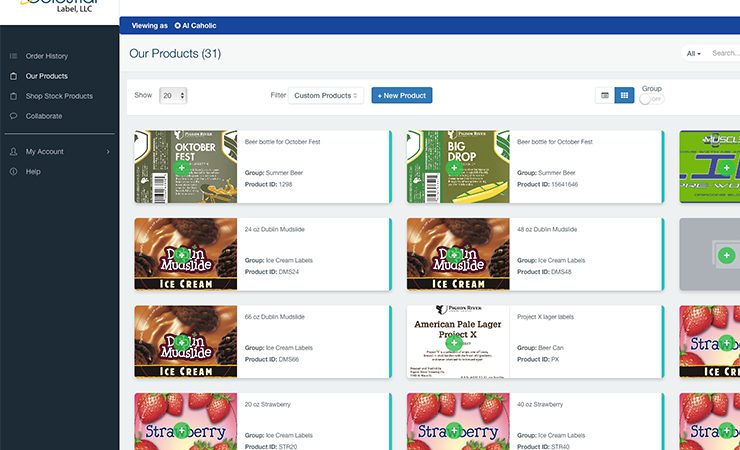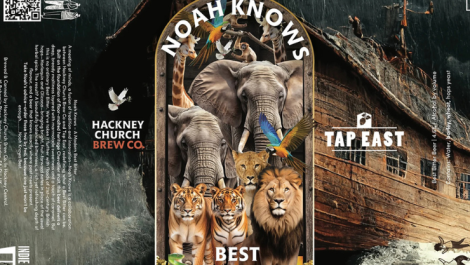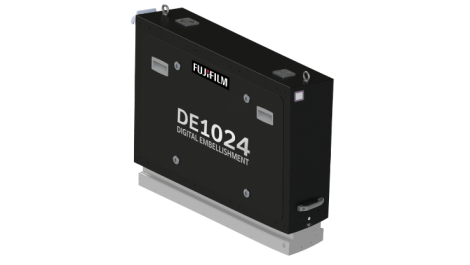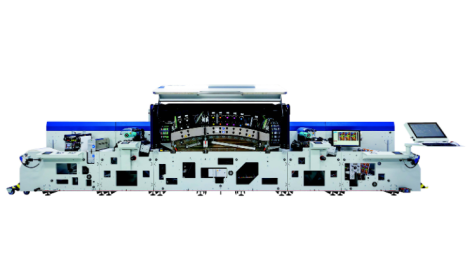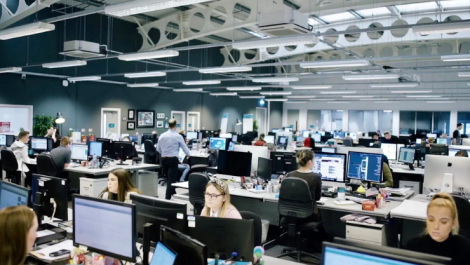Whichever digital print for packaging vertical you operate in, an unmistakable truth is the role the systems you have in place to bring jobs in, process them, send them to press, and push them out of the door.
These are not only important, they are downright critical when you consider modern print business operating environments – from the pressure of faster and wider throughputs as necessitated by the new generation of digital flexible packaging presses, to what corrugated packaging converters have experienced as a consequence of Covid-19 and the stratospheric rise of e-commerce.
‘If the pandemic has taught us anything it is that you have to plan for the unexpected,’ says Workflowz founder Alan Dixon. ‘Customers who invested in building resilience into their processes, but ensuring they had flexibility too, were best able to adjust to a constantly changing commercial landscape.’
Chris Spooner, business development manager at Label Traxx, says, ‘Correct software and workflow tools are so important for modern day printing environments as they form the foundations for success. Huge investments are made into new printing technology and these must be supported by streamlined workflows. Processing multiple jobs quickly enables a printing press to remain in production. If a company can produce more quotes efficiently and win more business then this is also an advantage.’
Mr Dixon adds, ‘Speed has been a problem, but you don’t simply want to move from one bottleneck to another. Computers, networks and the internet have all become faster and that has enabled platforms to perform at a level of throughput that were once only a dream. This foundation has allowed software developers to harness that power and provide solutions that are not just rules based, but dynamic and responsive to real-life conditions and variables that used to throw production into a meltdown.
‘Most vendors now provide an open architecture with API and connectivity options, as each component is part of the bigger jigsaw puzzle.’
Add to that many production machines are now set-up automatically and switchover times are reduced to a minimum, with MIS and pre-press workflow software delivering the information to instruct these machines.
‘When MIS and pre-press are seamlessly interfaced to each other and to the production equipment, operators just have to switch the necessary physical elements without entering instructions,’ notes Cerm managing director Geert Van Damme.
‘On top of this, the consecutive job instructions throughout the complete production chain will be in sync. The last printed frame will be followed by the ‘set-up waste’ for the first finishing process of a printed roll. In allowing MIS to fulfil its central role to drive production, the reduction of production time and material waste will even be bigger.’
Workflow integration and process optimisation are thus becoming more and more important, as Heidelberg has identified through the development of Prinect. It has observed the change from manual work to industrial production, alongside the move from machinery viewed as ‘production islands’, to full integration into the complete workflow. Prinect software is designed to reduce touchpoints significantly, as well as manual interventions in order acceptance, data transfer or post-processing.
printIQ’s management workflow system (MWS) similarly reduces touchpoints, whilst streamlining production and assuring an end-to-end production environment and eliminating ‘production islands’.
Paul Bromley, head of sales, EMEA at printIQ, says, ‘Integration has become an issue for many print businesses that have standalone MIS systems. The development of APIs has meant some investments can be kept rather than complete overhauls when extending a system’s capabilities. Yet a pieced together legacy system at some time will cause incompatibilities. Incompatibilities that a dedicated end-to-end MWS will avoid.’
CGS Oris points to the number of different printing devices now available, and also the palette of printed products. With digital printing presses opening up greater flexibility and customisation options, there is greater need to handle all these different presses optimally to get the best possible printing results, and achieve colour consistency and stability.
CGS Oris CEO Bernd Rückert says, ‘Of course, it is not just the presses, it is also the optimisation of workflows, the evaluation and avoidance of errors and the need to deliver very fast expected quality to customers, which makes the implementation of the right software tools a very sustainable investment.
‘Today, colour management companies are much more than just software manufacturers; they are colour consultants who support companies to build up customised workflows or to optimise existing infrastructures to gain more profit.’
Mr Van Damme advises that such developments do not take away the challenge of interaction throughout the entire value chain. ‘We cannot expect all vendors to connect to all other vendors to retrieve data for their next step in the production. Only a smart workflow system, connected to many vendors, like the Cerm MIS will add this extra dimension.’
Thomas Elton, Cloudflow product manager at Hybrid Software, identifies that as the printing process can have ‘many moving parts’ – from project management, to production, manufacturing and delivery, via the various pre-press and approval steps – it is necessary for all these steps to work together collaboratively to deliver the optimum outcome, for the printer and the customer.
‘The problem with any process that has moving parts is ensuring they are communicating correctly and consistently,’ he notes. ‘This is why it’s vital to use the correct tools for the job, such as pre-press editing tools and workflow solutions that can communicate with MIS/ERP systems, manage approvals and asset management, and prepare and drive the digital files for printing whether digital or conventional.’
‘The world today has changed and although we were aware that automation was the right investment for digitally printed packaging and labels, the pandemic has highlighted the need for automation more than ever,’ affirms Paul Bates, UK, Ireland, and global account sales manager at Hybrid Software.
‘The systems should be accessible via a web browser without the need to install software. I know this sounds obvious but you would be amazed at the number of printers that couldn’t allow homeworkers to access their systems during Covid restriction without a convoluted configuration with virtual desktops.’
The sky is the limit
Mr Elton sees ‘more and more’ software moving from physical to virtual environments, or a combination of the two. ‘This overcomes many challenges business owners face when tackling failover and redundancy,’ he notes. ‘Looking forward, we see print professionals utilising the power of a centralised processing cluster that’s available from anywhere, anytime without constraint, thus removing the need to invest in site-specific software that is locked to a certain location.’
Cloudflow RIP Farm is a clustered set of individual RIPs that are all hosted in the Cloud, which Mr Elton describe as, ‘a real revolution for multi-site businesses who no longer want to invest in costly RIP software that can only be used locally per site.
‘It also circumvents the bottleneck of high volumes of production not being easily load balanced evenly across other more capable sites.’
Tharstern has developed ‘Cloud’, a Cloud-native MIS platform built using an ‘API first’ approach, with a fully accessible API that allows companies to synergise their MIS with other software applications and allow crucial data to be passed from one application to another at any level. This product will initially be available to the label sector, but over the coming years development will continue to make the product available for other print sectors, under the ‘Tharstern Cloud’ moniker.
theurer.com is likewise expanding its Cloud-based services, driven by the fact that as remote working becomes more and more popular, it is important that all modules can be reached from everywhere and work is made possible from anywhere. To enable all users to do that, theurer.com is working on switching all modules to being browser-based.
For Mr Bromley, a Cloud-based option with an online web portal providing access from anywhere, at any time is, ‘the answer.’
He explains, ‘The ability to process orders with minimal effort is vital for any operation to remain competitive in a world where ‘next day’ has become standard. Customers expect to see updates on the status of their order and when their delivery will arrive. They also want access that exceeds the traditional 9 to 5.’
Automate to innovate
Automation of tasks, and integration of different software systems has similarly helped push MIS and other workflow tools on Stephen Miller, director of product management, workflow software at Kodak, says, ‘From the moment new work enters the business to delivery and invoicing, printing businesses are a mix of orchestrated and structured activities and ad hoc business decisions. Savvy print operations leverage smart automation because every touchpoint brings potential delays and costs.’
Kodak’s Prinergy on Demand Business Solution harnesses the power of artificial intelligence (AI), including machine learning (ML), to collect data and provide insights. This does more than programme repetitive tasks, rather learns over time by watching for patterns and adjusting to compensate for emerging needs.
For Gallus and parent company Heidelberg, flexibility is going to be key in the future, helping customers remain competitive. The Prinect Digital Frontend has been especially designed for the modular Labelfire platform. Numerous functions for automated digital production and integration into Prinect Workflow are implemented. This helps enable automated preflighting and PDF optimisation, impositioning, spot colour matching, job management, and VDP data preparation.
Cerm’s developments are industry-specific and are product oriented, such as its new packaging software that is now in the hands of several customers for testing and optimisation. It has also released v7.25 of its software for labels with new features such as online pre-payment, a new and enhanced production monitor, and smart business intelligence capability.
The new version of CGS Oris’ Flexo Pack enables direct-to-substrate proofing, as well as extensive effects that create competitive advantages for its customers, and provide a means to attract and win new business. theurer.com’s C3 MIS/ERP software is specialised on the needs of the label and packaging industry. The latest product of the company is a fully automated production optimisation and planning tool, using AI. With the new module, scheduling is simplified and mistakes are reduced.
Automated scheduling will be part of the next wave of workflow improvements, suggests Mr Spooner, with, ‘Most printers struggling to optimise the entire planning and scheduling process due to the number of variables that need to be juggled.’ For example, changing lead times, machine and labour constraints, machine changeovers and waste all need to be taken into consideration.
Label Traxx has introduced Batched.io as a tool for automated scheduling, and which can establish a set of rules and priorities to tailor the program to specific manufacturing environments. This module combines industrial engineering, predictive analytics, AI, ML, and a batching heuristic.
W2P
Within the workflow ecosystem, one of the big talking points in recent times has been W2P.
Siteline represents Label Traxx’s W2P play, and can integrate with key areas of a print business, from quotations, order approvals and artwork approvals, which can then link to pre-press automation software. Mr Spooner calls to attention the ability for advanced artwork approval to show layers that include foiling, debossing/embossing, and screen printing. Siteline also allows multiple people to sign off various projects, whilst the acceptance of credit card payments allows customers to pay for packaging online.
Norway’s Ellco Etikett is a Label Traxx customer, using both Siteline and the aforementioned Batched. The company has a vision to automate as much of its operations as possible, so says the printer’s general manager, Christian Egedius.
‘With this, we aim to reduce costs, increase quality, and provide our customers a better service. In Siteline, customers can access all of their products, order history and artwork proofing 24/7. Their questions are answered online, freeing up time for our sales and customer service.’
According to Mr Dixon, empowering the customer to self-serve is a vital part of the W2P journey. ‘Everyone is time-poor and more links in a chain are more points of weakness.
‘Whether that is approving proofs online, checking colour, optimising images automatically for editorial publishing, customising and adapting marketing material online (whilst adhering to brand guidelines) or simply being dynamic in being able to gang impositions for the irregular and varied quantities of orders that needed to be turned around quickly.’
Mr Bromley says, ‘Print management systems need to offer the ability to truly control all touch points, giving full visibility to internal team members and their customer base.
‘Orders should be automated from websites or online portals directly into production including the option of automated preflight checks on artwork, automated proofing approvals, and even automated shipping integration. Automation not only of the end-to-end process for key products, but also of business processes in their entirety.’
This article was first published in the July/August 2021 issue of Digital Labels & Packaging, which can be read online here

